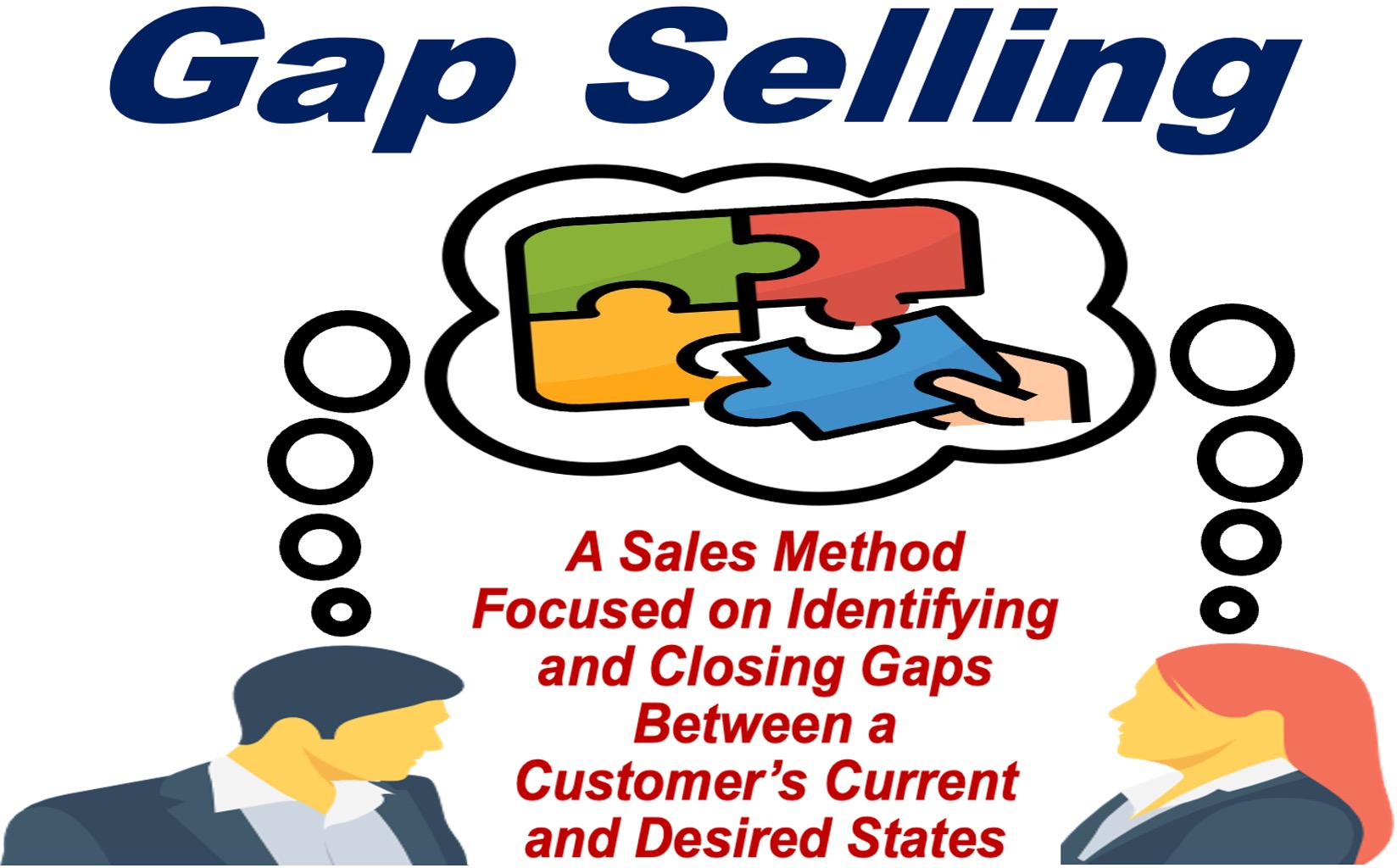Do you focus on addressing the gap between where your customer is now and where they want to be? If so, you practice Gap Selling or Gap Sales – you are a Gap Seller.
Your sales approach is not just about selling your product; it’s about understanding your customer’s or *prospect’s current state, recognizing the challenges or problems they face, and offering a solution that helps them bridge the gap to reach their desired outcome.
* A prospect is a person who you think could become a paying customer. For the rest of this article, the word ‘prospect’ can also refer to ‘customer,’ and vice-versa. The same applies to ‘product’ and ‘service’.
Builtin.com has the following definition of gap selling:
“Gap selling is a problem-centric approach to sales in which reps look at the full scope of the customer’s problem and identify their “gap,” or the difference between where the customer is today and its ideal future. Closing that gap becomes the foundation for all future sales conversations.”
Show You Can Fill That Gap
At the core of gap selling is the idea that your customers are seeking a transformation. They have a goal, a problem to solve, or an outcome they want to achieve, and there’s a gap between their current situation and that goal.
Your role as a seller is to uncover this gap and demonstrate how your product or service can help close it.

Gap Selling and Understanding the Current State
The first step in gap selling is to gain a deep understanding your customer’s current state.
This involves asking probing questions to gain insight into their challenges, pain points, and limitations.
You need to be curious and dig deep to understand what’s not working for them and why. Listen very carefully to their answers. You should never underestimate the importance of active listening. The world’s most successful salespeople share an important quality: they all know how to listen.
The information they give you is crucial because it helps you frame the conversation around their needs rather than just pushing your product.
Identifying the Desired Future State
Once you have a clear understanding of your customer’s current state, your next step is to explore their desired future state.
What do they want to achieve? What are their goals? By understanding where they want to be, you can start to paint a picture of how things could be better for them. This vision of the future is what motivates your customer to take action.
Highlighting the Gap
After you have a clear picture of both the current state and the desired future state, the gap becomes evident.
This gap represents the distance between where your customer is now and where they want to be.
In gap selling, this gap is your opportunity. It’s where your product comes into play.
By focusing on this gap, you can demonstrate the value of your offering in a way that is directly relevant to their needs.
Examples of Gaps
Here are some common gaps that salespeople identify:
- Knowledge Gap: The customer lacks information about how to solve their problem.
- Resource Gap: The customer does not have the necessary tools or services to achieve their goals.
- Strategy Gap: The customer’s current approach is ineffective or misaligned with their desired outcomes.
- Expectation Gap: The customer has unrealistic or unmet expectations about what a product or service can deliver.
- Communication Gap: There is a disconnect in understanding between the salesperson and the customer, leading to misaligned messages or expectations.
- Engagement Gap: The customer is not fully engaged or committed to the buying process, which could hinder progress or decision-making.
Closing the Gap
Your final step is to position your product as the solution that will help your customer close the gap.
You need to show them how your offering will address their specific challenges and enable them to achieve their goals.
It’s not just about your product’s features and benefits; it’s about making a clear connection between your solution and the gap they need to bridge.
Gap Selling – Brief History
Gap selling, popularized by Keenan in 2018 with his book “Gap Selling: Getting the Customer to Yes,” emphasizes the importance of identifying and closing the gap between a customer’s current state and their desired future state.
It quickly gained popularity for its problem-centric approach, which focuses on deep discovery of customer needs rather than traditional sales techniques.
Today, gap selling is widely adopted in modern sales practices. Additionally, this methodology is becoming particularly popular in B2B (business-to-business) environments where complex, consultative sales processes are common.
Similar Methods to Gap Selling
In the world of selling, there are many different methods that salespeople use. The following five are all problem-centric and consultative, closely mirroring the principles of gap selling:
Like gap selling, solution selling focuses on identifying a customer’s problem and providing a tailored solution that bridges the gap between their current and desired states.
Both methods emphasize understanding customer pain points, but challenger selling also involves challenging the customer’s thinking to drive change.
Similar to gap selling, insight selling involves understanding the customer’s issues and providing insights that reshape their view, guiding them to a solution.
This method, like gap selling, focuses on identifying and addressing the specific needs of the customer.
SPIN selling aligns with gap selling by using questioning techniques to uncover and address the customer’s challenges.
Final thoughts
Gap selling is about understanding your customer’s current situation, recognizing where they want to be, and then positioning your product or service as the bridge that will help them get there.
By focusing on the gap, you make your sales approach more relevant, targeted, and effective.
